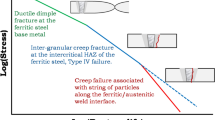Abstract
Modern and future power plants will use more complex materials to withstand the higher steam temperatures and pressures as well as thermal cycling. As such, dissimilar metal welds (DMWs) will be more widespread in new design than before and will need to demonstrate resistance to combinations of severe creep, corrosion/oxidation, and low cycle fatigue. The DMWs between different steels or alloys are an underestimated topic. Experienced and documented premature failures reveal the criticality of DMWs. This study focused on the DMWs between 9Cr martensitic creep strength enhanced ferritic steels and advanced austenitic stainless steels. Two collaborative projects related to 18%Cr and 25%Cr austenitic creep resisting stainless steel delivered data concerning base metal characterization and weldability of similar and dissimilar welding. The specific features of dissimilar welding are further approached in more detail in this analysis. Two main methodologies, i.e., direct welding and buttering techniques using different filler metals were investigated and characterized via uniaxial creep rupture testing and metallographic examination particularly focusing on the fusion line carbide formation and morphology. For the limited exposure times of 10 kh in this project, the results show that aligned and coarse type I carbide formation is occurring at the 9Cr fusion line between A617 type weld metal. The selection of P87 or A82 type filler metals demonstrated isolated to partly aligned carbides, respectively, at the fusion line. To mitigate the risk to corrosion and achieve a marginal increase in creep performance, buttering techniques are recommended.









Similar content being viewed by others
References
Salzgitter Mannesmann Stainless Tubes-Boiler Grade DMV304HCU
Salzgitter Mannesmann Stainless Tubes-Boiler Grade DMV310N
Iseda A, Okada H, Semba H and Igarashi M (2008) Long-term creep properties and microstructure of Super304H, TP347HFG and HR3C for advanced USC Boilers, 5th Int. Conference on Advances in Materials Technology for Fossil Power Plants, 3–5 October
Friedmann V and Siegele D, Damage behavior of nickel-based transition welds under cyclic thermomechanical loading, Materials at High Temperatures 27 pp. 35–43
Penso JA, Belanger P - Mitigating failures in ferritic-austenitic dissimilar metal joints in petrochemical industry, ASME PVP 2013 (PVP2013–97550)
Omar A (1998) Effects of welding parameters on hard zone formation at dissimilar metal welds, AWS Welding Journal pp. 86 s–93 s
Siefert JA, Sanders JM, Tanzosh JM, Newell WF Jr and Shingledecker JP, Development of EPRI P87 solid wire, Materials at High Temperatures 27 pp. 243–252
Siefert JA, Tanzosh JM, Shingledecker JP and Newell WF Jr (2011) EPRI P87: a promising new filler metal for dissimilar metal welding, AWS Welding Journal pp. 30–34
Shingledecker J, Coleman K, Siefert J, Tanzosh J and Newell W, High-temperature performance of a new nickel-based filler metal for power generation applications
BWI—new generation austenitic steels X10CrNiCuNb18-9-3 (Super 304H/DMV304HCu/TX304HB)—weldability and high temperature properties—technical report
BWI—new generation austenitic steels X6CrNiNbN25-20—technical report (in progress)
DuPont JN, Microstructural evolution and high temperature failure of ferritic to austenitic dissimilar welds, Int Mater Rev 2012 (57) No 4 pp. 208–234
KULeuven Master Thesis—Faculty Engineering Technology—Dissimilar metal welds-impact of type I/II carbides on creep life” (Academic Year 2014–2015)
Roberts DI, Ryder RH and Viswananthan R (1985) Performance of dissimilar welds in service – J Press Vessel Technol Vol. 107 pp. 247–254
Vekeman J, Huysmans S and De Bruycker E (2014) Weldability assessment and high temperature properties of advanced creep resisting austenitic steel DMV304HCu – Welding in the World Vol. 58 pp. 873–882
EPRI TR 1019786 December 2011, Repair methods for dissimilar welds-development, weldability and properties of EPRI P87 solid wire filler metal [2920]
Acknowledgements
The authors would like to thank the Federal Government Department Public Services Economy and Engie for their financial support of the pre-normative research projects. Also, the industrial partners are gratefully acknowledged: NSSMC, Saltzgitter Mannesmann Stainless Tubes, Vallourec & Mannesmann Tubes, Böhler Welding Group (Soudokay), Metrode for delivering base material and filler metals, Cockerill Mechanical Industries, Stork Technical Services, Cofely Fabricom GDF Suez, VCL for welding, AIBVinçotte for nondestructive examination, and SIRRIS for chemical analysis.
Special thanks to Mr. M. Neyens (student at KUL University Leuven-MSc Welding Engineering) and to Dr. Ir. F. Vos (materials consult/KUL) as the author and copromoter/reviewer, respectively, of the Master thesis which supplied valuable input for the project.
Author information
Authors and Affiliations
Corresponding author
Additional information
Recommended for publication by Commission XI - Pressure Vessels, Boilers and Pipelines
Rights and permissions
About this article
Cite this article
Huysmans, S., Vekeman, J. & Hautfenne, C. Dissimilar metal welds between 9Cr creep strength enhanced ferritic steel and advanced stainless steels—creep rupture test results and microstructural investigations. Weld World 61, 341–350 (2017). https://doi.org/10.1007/s40194-016-0414-9
Received:
Accepted:
Published:
Issue Date:
DOI: https://doi.org/10.1007/s40194-016-0414-9




